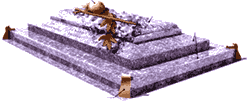Designing and Constructing
As custodian of the National War Memorial, Public Works and Government Services Canada was responsible for designing and constructing a tomb where the unknown Canadian soldier brought home from the cemetery at Vimy in France was laid to rest.
Located on the upper plaza of the National War Memorial, in Ottawa, in front of the existing monument, the Tomb consists of a granite sarcophagus enclosing a casket containing the remains of the unknown soldier. A bronze relief sculpture is secured to the top with stainless steel pins. The four corner pieces of the sarcophagus also have bronze relief work.
The Sarcophagus

The three-tiered sarcophagus is 12 feet long, 8 feet wide and 3 feet high. Dark Caledonia granite, quarried in Rivière à Pierre, Québec, was selected to complement the paler-coloured stone used in the National War Memorial. While it is patterned after the stone altar of the Vimy Memorial, the severe Ottawa climate, as well as the bronze and stone makeup of the National War Memorial, led to the decision to produce the relief work in bronze.
The Bronze Relief Sculpture
The sculpture, cast in Roberts Creek, British Columbia, includes the key elements of the stone carving on the Vimy altar; a medieval sword, a helmet of the type worn in the First World War, with branches of maple and laurel leaves. The laurel leaves symbolize both victory and death. Four bronze corner pieces containing symbolic mementos of mourning enhance the sculpture.
The Four Bronze Corner Pieces
Three of the corner pieces are decorated with large replicas of the Memorial Cross. First instituted in 1919, the Cross is presented to the family of those who gave their lives while serving Canada in war or on peacekeeping missions. The three Crosses are slightly different; each has the Royal Cypher of one of the successive monarchs since its inception (George V, George VI, and Elizabeth II). On the fourth corner piece there is a replica of a poppy, representing those who may fall in future conflicts. The curved shape of the corner pieces will echo the curve of the top of the War Memorial.
The Artist

The sculpture was created by Mary-Ann Liu, a well-known Canadian artist from Mission, British Columbia, who works with a variety of materials. A sculptor and designer for 15 years, her work has been exhibited as far away as Japan.
Selecting the Design

The design selected for the bronze relief was the unanimous choice of the selection committee. It was one of six submissions received from internationally renowned Canadian artists from across the country who were invited to submit their designs. The selection committee comprised representatives from Public Works and Government Services Canada, Veterans Affairs Canada, the Department of National Defence, the National Capital Commission, the Royal Canadian Legion, a former Dominion Sculptor, a sculpture restoration specialist and a design consultant.
Lighting
A light mounted on the roof of a nearby building illuminates the Tomb, and new lighting was installed to enhance the National War Memorial itself.
- Date modified: